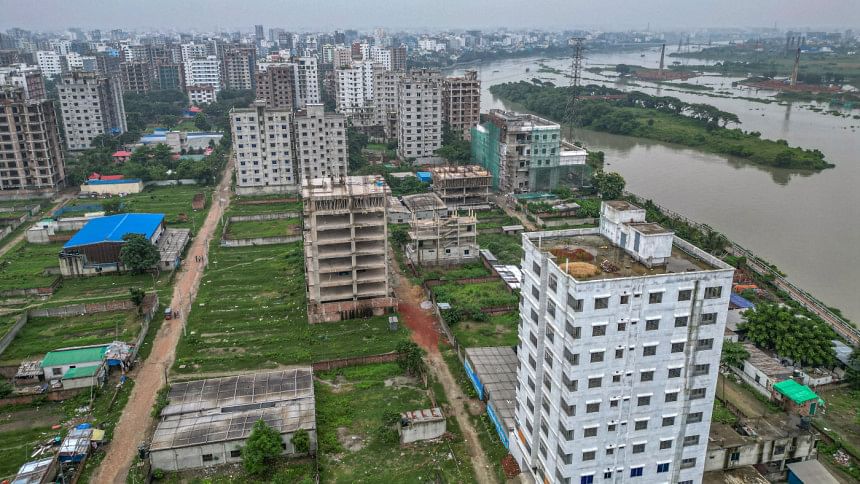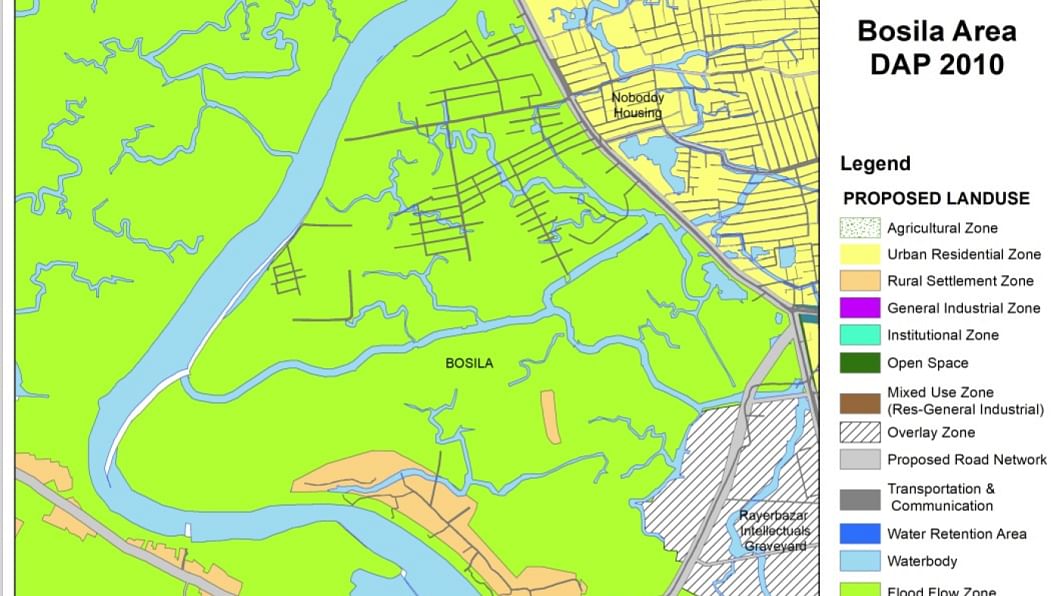Dhaka’s disappearing flood-flow zones

Once the lifelines of Dhaka, the city's canals are now mere shadows of their former selves—clogged with pollution, suffocated by encroachment, and neglected due to flawed urban planning. In this seven-part series, The Daily Star explores the current condition of the capital's canals, botched restoration attempts, and how the sorry state of these waterways is exacerbating the city's waterlogging woes. Together, these stories reveal what it will take to bring Dhaka's dying canals back to life. Here is the fourth part of the series:
Flood-flow zones, crucial for maintaining Dhaka's ecological balance, are rapidly vanishing, leaving the city increasingly vulnerable to waterlogging, loss of groundwater recharge, and potential flooding.
Experts and urban planners blame rampant encroachment, questionable policies by the Rajdhani Unnayan Kartripakkha (Rajuk), and a culture of impunity that has legitimised illegal land use.
FLOOD-FLOW ZONES: A CRITICAL RESOURCE
Flood-flow zones are designated low-lying areas meant to retain water during monsoons, preventing urban flooding and aiding groundwater recharge. Historically, these zones ensured that excess water from rivers like the Buriganga had natural outlets, reducing the risk of flash floods and waterlogging.
However, Dhaka has lost vast swathes of these zones due to unplanned urbanisation.
According to a 2019 study by the Bangladesh Institute of Planners (BIP), the city lost 1,072 acres (57 percent) of its 1,879-acre flood-flow zones in metropolitan areas within a decade.
Till 2019, since the publishing of the gazette on the previous master plan (DAP-2010), the city lost 3,440 acres out of 9,556 acres of flood-flow zones, water retention areas, and water bodies.

POLICIES FUELING ENCROACHMENT
The Detailed Area Plan, approved in 2023, has drawn severe criticism for legalising residential developments in previously conservable flood-flow zones.
While the DAP imposes penalties for unauthorized construction under the Building Construction Rules, these penalties remain negligible, with no substantive action against encroachment.
"This is a glaring weakness of Rajuk and the DAP," said Fazle Reza Sumon, former president of BIP. "This legalisation benefits certain quarters, encouraging others to encroach upon flood-flow zones with the hope of eventual regularization," he said.
Rajuk has further divided flood-flow zones into "open flood-flow zones" and "general flood-flow zones".
While development is restricted in open zones, conditional development is now permitted in general zones, reducing the total flood-flow area by 23 percent.
"Rajuk has effectively legitimised encroachments and now has the power to alter land use based on individual or other considerations," said Iqbal Habib, vice president of Bangladesh Paribesh Andolon. "This will reduce Dhaka's flood-flow zones to a mere 26 percent of their original size."
CONSEQUENCES FOR DHAKA'S ENVIRONMENT
The gradual loss of flood-flow zones has dire implications for the city. Without sufficient floodplains, rivers like the Buriganga face reduced inflows, endangering their ecological health.
"When houses are built on elevated flood-flow zones, roads are also raised, creating low pockets that trap water," explained Iqbal Habib. "This leads to severe waterlogging in areas like Kalabagan, Kathalbagan, Rayerbazar, Matikata, and the DND region."
Mohammad Azaz, chairman of the River and Delta Research Centre (RDRC), highlighted how Dhaka has transformed from a wetland city into a concrete maze.
"Dhaka should have been a sponge city, retaining water during rains. But unplanned urbanisation and inadequate town planning have buried natural water channels and wetlands, leaving the city defenseless against flooding."
Adil Mohammad Khan, president of BIP, added, "Flood-flow zones were once restricted for farming and water retention, ensuring natural flood mitigation. Now, the absence of penalties for encroachments has made the current DAP toothless."
Iqbal Habib warned, "Without sufficient flood-flow zones, Dhaka will face increased flash floods and river flooding. Vulnerable areas along the Buriganga's banks and other low-lying pockets will suffer the most."
HOUSING PROJECTS: GOVT, PVT CULPRITS
Government agencies have played a leading role in this crisis by developing large housing projects on wetlands, such as Uttara phases 1, 2, and 3, Purbachal, Jheelmil, and Baridhara J Block, according to experts.
Private developers followed suit, with Jahirul Islam's Banasree and Eastern Housing becoming models for indiscriminate wetland encroachment, said Azaz.
"Even local housing societies are now filling wetlands and flood-flow zones for new projects," added Iqbal Habib.
The Drainage Masterplan 2016 by Dhaka Water Supply and Sewerage Authority (Wasa) revealed that many back swamps, depressions, and natural channels have already been filled in Dhaka, exacerbating the city's drainage issues.
THE WAY FORWARD
Experts emphasise that protecting flood-flow zones require strict enforcement of existing regulations and meaningful penalties for encroachment. Developing Dhaka's town planning with a focus on ecology and sustainability is also crucial.
"The government must prioritise ecological and social considerations over mere land use," said Azaz. "Dhaka's survival depends on its ability to balance urbanisation with environmental preservation."
Stressing the need for proper protection of flood-flow zones, Adil said any type of development should be completely restricted in the flood-flow zones around Dhaka.
He said main flood-flow and sub-flood flow zones should be merged in the DAP to prohibit any types of development in these areas as they are imperative for water retention and protecting biodiversity, he added.
"Vested interest groups that were involved in the destruction of flood-flow zones for housing, industry, or other activities, should be identified and penalised accordingly. Culpable officials of Rajuk, DoE, water development board, DC office, and other government offices should be punished as well for their misconduct," Adil said.
Adil said environmental laws should be modified and amended to increase the punishment for encroachers of flood-flow areas.
"Connectivity between different canals, waterbodies, and water channels should be restored. Appropriate demarcation of flood-flow zones is necessary as well and community engagement is also required to conserve these areas," he said.
Unless urgent action is taken, the city risks losing its remaining flood-flow zones, leaving its population exposed to unmanageable water crises in the years to come, experts warned.

 For all latest news, follow The Daily Star's Google News channel.
For all latest news, follow The Daily Star's Google News channel. 




Comments